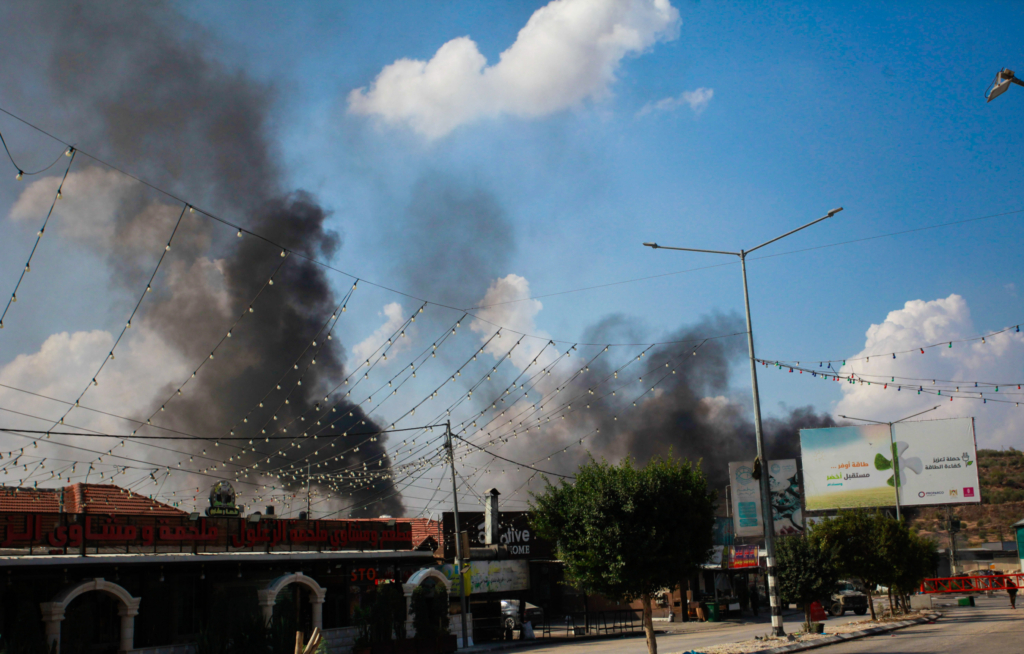Amnesty International has for decades
documented widespread torture by Israeli authorities in places of detention across the West Bank. However, over the past four weeks, videos and images have been shared widely online showing gruesome scenes of Israeli soldiers beating and humiliating Palestinians while detaining them blind-folded, stripped, with their hands tied, in a particularly chilling public display of torture and humiliation of Palestinian detainees.
In one image analysed by Amnesty International’s Crisis Evidence Lab, three Palestinian men, blindfolded and stripped of their clothes can be seen beside a soldier, wearing a green olive uniform like those worn by the Israeli ground forces. A Haaretz
investigation published on 19 October found that the image was taken in Wadi al-Seeq, a village East of Ramallah, on 12 October. One of the three victims depicted in the photograph told Amnesty International that he had initially been held and beaten by settlers but two hours later an Israeli military jeep arrived:
“One of the Israeli officers who came, approached me and kicked me on my left side, then jumped on my head with his two legs pushing my face further into the dirt and then continued kicking me as I was head down, into the dirt, with my hands tied behind my back. He then got a knife and tore all of my clothes off except for my underwear and used part of my torn clothes to blindfold me. The beating to the rest of my body did not stop, at one point he started jumping on my back – three or four times – while yelling ‘die, die you trash’ … in the end before this finally stopped, another officer urinated on my face and body while also yelling at us ‘to die’.”
Amnesty International also spoke to two women who were arbitrarily detained for 14 hours at a police station in occupied East Jerusalem where they were humiliated, strip-searched, mocked and asked to curse Hamas. They were later released without charges.
In a video first published on social media on 31 October and analysed by Amnesty International’s Crisis Evidence Lab, nine detained men, who based on identifiable accents are Palestinian, can be seen, some stripped naked and others half-naked, blindfolded and handcuffed, surrounded by at least 12 soldiers wearing olive green uniforms and equipped with either M4A1 or Tavor X95 assault rifles. Both uniforms and weapons are standard issue equipment of the Israeli ground forces. One of the soldiers is seen kicking one of the detainees in the head. Another video analysed by Amnesty’s Crisis Evidence Lab uploaded to platform X (formerly Twitter) on 31 October shows a blindfolded person, likely Palestinian, along with an Israeli army sergeant mocking the prisoner and dancing around him.
A recently released Palestinian detainee from occupied East Jerusalem, who spoke to Amnesty International on condition of anonymity, said how Israeli interrogators subjected him and other detainees at the Russian Compound (al-Maskoubiyeh), a detention center in Jerusalem, to severe beatings which left him with bruises and three broken ribs. He also highlighted how Israeli police interrogators beat them continuously on their heads yelling at them to always keep their heads down, while ordering them to “praise Israel and curse Hamas.” He added: “even when one of the 12 detainees with us in the cell did that, the beating and humiliation did not stop.”
Since 7 October, according to the Israeli authorities, four Palestinian detainees
have died in Israeli detention facilities in circumstances that have not yet been impartially investigated.
Two of the four are workers from the occupied Gaza Strip, held incommunicado by the Israeli army in military detention centres, whose deaths were only made public by the army after an inquiry by Israeli newspaper Haaretz.
Under international law, torture and other ill-treatment committed against protected persons in an occupied territory is a war crime. The detention of protected persons outside the occupied territory, as is the case of Palestinian prisoners from the OPT held in Israel, is also a violation of international humanitarian law as it amounts to forcible transfer.
 The irony of Ye having produced that.
The irony of Ye having produced that. The irony of Ye having produced that.
The irony of Ye having produced that.
Look what they did to the poor young man. The modern day nazi's indeed

Look what they did to the poor young man. The modern day nazi's indeed
 Y’all scared of the Houthis.
Y’all scared of the Houthis.Y’all scared of the Houthis.